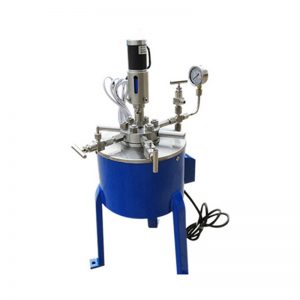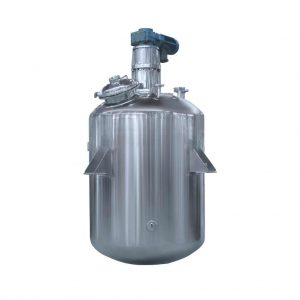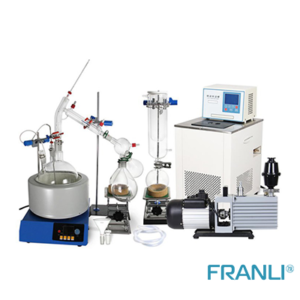Home » Glass Reactor & Chemical Equipment
Glass Reactor & Chemical Equipment
Glass Reactor
The main components of a glass reactor include the reactor body, lid, various ports, and accessories. The reactor body is typically a cylindrical glass vessel, with sizes ranging from small benchtop reactors to large reactors exceeding 150 liters. The lid has multiple ports for connecting accessories such as stirrers, condensers, and temperature probes. The bottom of the reactor also has a drain port for emptying liquids or circulating solutions .
Details of Glass Reactor
- Using the latest reaction technology
- It has high temperature resistance, corrosion resistance, and high durability.
- Heating methods include steam, electric heater, high temperature heat transfer oil
- Using jacket, half pipe, fan coil, and other structures
Application: Chemicals, pharmaceuticals, dyes, pesticides, petroleum, food additives, etc.
Glass reactors are essential equipment widely used in the chemical, pharmaceutical, and biotechnology industries. They come in various types, suitable for different applications.
Types of Glass Reactors
Based on their structure and function, glass reactors can be classified into the following main types:
1. Single-Walled Glass Reactors
Single-walled glass reactors are the most basic type, consisting of a glass vessel and a heating or cooling jacket. They are widely used for simple chemical reactions, distillation, and purification processes. The transparent design allows operators to conveniently monitor the progress of the reaction.
2. Double-Walled Glass Reactors
Double-walled glass reactors have an additional layer, providing insulation and improving temperature control performance. These reactors are suitable for reactions that require precise temperature regulation, such as crystallization and reflux experiments.
3. Triple-Walled Glass Reactors
Triple-walled glass reactors have an additional layer between the inner and outer glass vessels, further enhancing the system’s thermal insulation performance. They are typically used for reactions that require strict temperature control, such as polymerization reactions and precision synthesis.
4. High-Pressure Glass Reactors
High-pressure glass reactors are designed to withstand relatively high pressures and are suitable for hydrogenation reactions, catalytic reactions, and supercritical fluid extraction processes. They are equipped with reinforced glass vessels and robust sealing mechanisms to ensure safe and efficient operation under high pressure.
5. Photocatalytic Glass Reactors
Photocatalytic glass reactors are specifically designed for photochemical reactions. They consist of a glass vessel and a light source used to activate photocatalysts. These reactors are widely used in environmental research, water treatment, and solar energy conversion applications.
6. Rotatable and Liftable Glass Reactors
These glass reactors feature a manual lifting mechanism, making them convenient for large-scale operations. The pot-shaped reactor body can rotate, facilitating easy cleaning after experiments. They are instrumental in applications that require thorough cleaning and maintenance.
Working Principles of Glass Reactors
Glass reactors are used to conduct chemical reactions in a controlled environment. They are connected to external equipment (such as heaters, coolers, vacuum pumps, and stirrers) to control various aspects of the experiment, such as temperature, pressure, and stirring speed.
Reactants and solutions are loaded into the glass reactor body, and the transparent glass allows for visualization of the reaction process. As the reaction progresses, operators can adjust parameters like temperature, stirring rate, and pressure to optimize the reaction conditions.
Application Scope of Glass Reactors
Due to their excellent corrosion resistance, visibility, and ease of cleaning, glass reactors have widespread applications in the chemical, pharmaceutical, and biotechnology industries.
1. Chemical Synthesis
Glass reactors are widely used for the synthesis of various chemicals, intermediates, and specialty chemicals. Researchers can control reaction parameters (such as temperature, pressure, and stirring speed) to optimize yield, selectivity, and reaction kinetics.
2. Reaction Condition Screening
Glass reactors enable efficient screening of different reaction conditions, allowing for the exploration of new chemical transformations. Researchers can simultaneously test multiple variables to determine optimal reaction conditions.
3. Temperature-Sensitive Reactions
Glass reactors equipped with precise temperature control systems are well-suited for temperature-sensitive reactions. Chemists can conduct reactions under specific temperature profiles to optimize reaction rates and product quality.
4. Hydrogenation and Oxidation Reactions
Glass reactors are used for hydrogenation and oxidation reactions, which have high demands for pressure and temperature control. These reactions are common in the pharmaceutical and fine chemical industries.
5. Photocatalytic and Photochemical Reactions
Specialized glass reactors equipped with light sources are used for photochemical reactions. These reactions utilize light energy to initiate chemical transformations and are widely applied in various chemical synthesis processes.
6. Polymerization Reactions
Glass reactors are used for polymerization reactions of various materials, such as resins, adhesives, and plastics.
7. Distillation and Crystallization
Glass reactors are used for solvent distillation, recovery of valuable chemicals, and compound crystallization processes.
8. Extraction
Glass reactors are used for the extraction of plant materials, separation of natural products, and purification of chemicals.
Maintenance and Upkeep of Glass Reactors
To ensure the proper operation and service life of glass reactors, it is essential to perform appropriate maintenance and upkeep.
1. Cleaning
Regular and thorough cleaning of the interior and exterior surfaces of glass reactors is crucial. Appropriate cleaning agents and ultrasonic cleaning equipment can be used to remove residues and contaminants. After cleaning, the reactor should be thoroughly rinsed and dried.
2. Inspection and Replacement of Consumable Parts
Regular inspection and timely replacement of consumable parts (such as gaskets, seals, etc.) are critical to prevent leaks and other failures. It is also important to inspect the glass vessel for cracks or other damage.
3. Instrument Calibration
Instruments connected to the glass reactor (such as thermometers, pressure gauges, etc.) need to be regularly calibrated to ensure accurate readings.
4. Lubrication
For reactors with mechanical seals, the sealing areas should be properly lubricated at regular intervals to extend their service life.
5. Storage
When not in use, glass reactors should be stored in a dry, cool environment and protected from collisions and damage.
6. Safety Precautions
When operating glass reactors, it is essential to follow relevant safety protocols, wear personal protective equipment, and use fume hoods to prevent chemical leaks and personal injury.
Through regular maintenance and proper operation, glass reactors can perform optimally and provide a reliable reaction environment for various chemical processes.
Welcome to send inquiry to us and let’s make a win win business together !
Guidelines For Chemical Reactor
FRANLI has several complete chemical reactor production lines. Our chemical reactor adopts the latest infinitely variable speed reducer device, the sealing device can be a mechanical seal, and the heating and cooling can adopt the structure of a jacket, half pipe, fan coil, etc., The heating methods include steam, electric heater, and high-temperature heat transfer oil to achieve different safe processing environments such as acid resistance, heat resistance, wear resistance, and corrosion resistance.

Laboratory Reactor: Guide to Stirring System
The laboratory reactor is composed of a pot body, a pot cover, an agitator, a jacket, a support and transmission device, a shaft seal device, etc.

Overview of Laboratory Reactor
Laboratory reactors, also known as lab reactors, are essential tools in scientific research, product development, and process optimization. These reactors provide a controlled environment for conducting chemical reactions, mixing, dispersing, and homogenizing processes.

What is A Stainless Steel Reactor?
Stainless steel reactors are essential equipment in various industries, including chemical, pharmaceutical, biotechnology, and food processing.

Glass Reactor & Chemical Equipment
Glass reactors are essential equipment widely used in the chemical, pharmaceutical, and biotechnology industries. They come in various types, suitable for different applications.

Operating Guide for Laboratory Reactors
Laboratory reactors play a crucial role in chemical research and development. Understanding the proper operating procedures is essential to ensure accurate results and maintain a safe working environment.

Glass Reactors and Selection of Stirring Blades
Glass reactors, also referred to as glass reaction vessels, are vessels made from high-quality borosilicate glass material.

